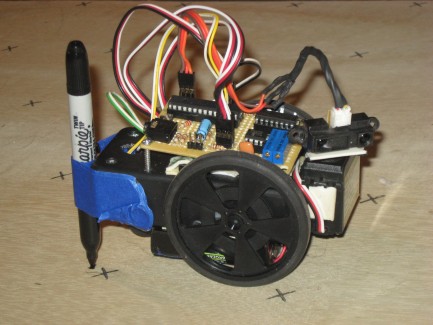Write Out "LMR"... Sorta...
Here's my shot at this challenge... I really didn't figure on how far the tail-end swings around during turns, but the basic shape is there! I am wicked happy with the encoders working and all the direction and distance commands were "pre-stored" on the EEPROM. Well, actually I just wrote a program that had all the directions and distances written out and I used it to store info to the EEPROM. In actuallity, I could have just entered that info directly into the drive code but it was cool to know I could store complicated instructions seperatly in an EEPROM and use them in a different chunk of code later. Well, I guess it is about time to solder up a stand-alone EEPROM programmer! For now, enjoy this silly video of my "Writer-Robot". (Bear in mind I have a wicked bad cold and I am all "sniffily" on the video)...
**Also, if you notice, on one side of the plywood, there are a series of 4 lines with marks on them. This is a little "jig" that I used on this guy to calibrate the IR distance sensors. I made a series of marks on lines indicating where each sensor was "looking". I then used a small block, wrapped in white paper, to set on each of the marks and using the DEBUG command could record what each sensor was spitting out. I did this test with the "white-paper-block" at 90 deg. to the beam and also at very shallow angle (to simulate a wall parallel to the direction of travel). I also used this method to find out how wide the "beam" was. I guess what I am saying is that the hour or so I took to draw-up this little test and record my results ended up with me cutting my "trial and error" coding in half. I cannot recomend enough that some step-by-step experimenting and recording the data will end up in far better code!**
Writes out "LMR"... Sorta
- Actuators / output devices: 2 GM3's
- Control method: Pre-programmed
- CPU: 28x1
- Power source: 3 AA's
- Programming language: Basic
- Sensors / input devices: 2 IR Encoders -Data stored in an EEPROM
- Target environment: A big chunk of plywood


